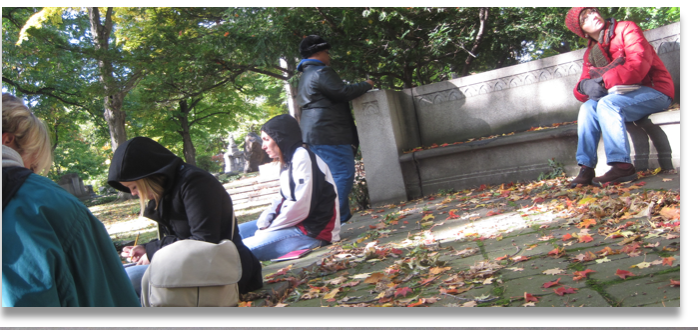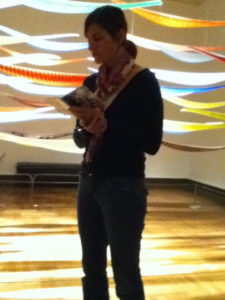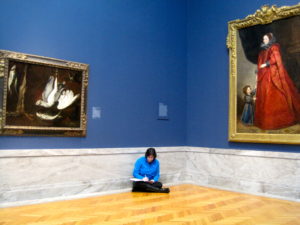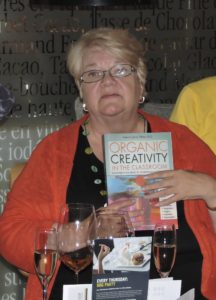A Week in Creativity (Essay)


A WEEK IN CREATIVITY
AN ESSAY BY
Jane Piirto, Ph.D.
Abstract
The author recounts a week in October, describing her teaching, writing, thinking, mail, and other activities that relate to her professional and personal work on creativity. This personal creative nonfiction piece also contains poetry and references to her books and lectures. The author chose this form in order to emphasize the autobiographical nature of work in the area of creativity.
A WEEK IN CREATIVITY
The Saturday was a gorgeous Ohio fall day, with orange and yellow trees, colorful mums planted in precise plots, people wandering along paved paths. The park was Inniswoods, a Columbus metropark, and I was here to meet six graduate students in education, studying for their endorsements to be gifted intervention specialists, taking their master’s degrees in Talent Development Education. They were five women and a man and we were on our Meditation Day for the course called Creativity Studies. Today we would meditate on nature, on the dark side, and on art and beauty.
I read several poems having to do with autumn and nature, by such poets as Gary Snyder, Mary Oliver, and Rainer Marie Rilke, as the students formed a circle. “This is your day,” I told them. “No kids, no duties, nothing to do but to meditate and think about your own creativity. The rules are simple. Walk alone and think. Meet back here by this bench in an hour and fifteen minutes. If you meet someone from the class, just acknowledge with a nod and move on.” I am of the philosophy that one can’t teach people to be creative unless one has explored her own creative self. The park was busy with photographers and their subjects—families and couples–. People walked on the boardwalk and on the packed dirt paths. When we met up after the hour, everyone shared one observation. Mike said the park was fake and loud. The others were more positive.
Our next venue for the day was a nearby cemetery. “We are here to put a concrete experience on the dark side as an inspiration for creativity. If you have recently experienced tragedy in your life, you do not have to participate in this meditation, but just enjoy the day.” I read some poems having to do with the dark side, one by Theodore Roethke, a poet who committed suicide; one by Allan Tate, “Ode to the Confederate Dead,” as the students turned and looked at the American flags flying next to many of the graves, indicating service in the military—this cemetery has graves from soldiers as far back as the Revolutionary War; and one of mine, about the massacre at Srebreniça in 1995. Again, the students dispersed with their Thoughtlogs (a daily assignment to make a note about their creative thoughts to encourage the core attitude of Self Discipline, an attribute which creative producers must have), with an admonition to think about the dark side as an inspiration for creativity.

Again we gathered after the meditation to share thoughts. Karla read a poem about the contrast between the traffic passing (this cemetery is on a busy corner), heedless of the inevitable fate that befalls us all. She is an English teacher with small children, being “at home” while she works on her Ph.D. She has always wanted to write fiction and poetry but has experienced self-censorship about her abilities. The poem is stunning, but I don’t tell her that as being over-praised is as killing to creativity as is criticism. She is going to do her final individual creativity project as a creative writer. She first wanted to make a backsplash for her kitchen counter out of tile, but I have, over the years, discouraged home projects in the HGTV mode, so she has reluctantly taken the risk (a core attitude) to work on her dream of writing creatively. Mike passed on sharing. He had sat on the grass writing furiously in his Thoughtlog. It turned out that he had lost his father in a pedestrian-car accident last year.
We drove a few miles downtown on I-71 for the next venue, the Columbus Museum of Art. We gathered there in the foyer for lunch where we had a creativity salon—we talked of music and art and books and politics—and not of our home lives, our children, or our jobs–. Then I read them some ekphrasis poems—Browning’s “My Last Dutchess,” and Keats’ “Ode on a Grecian Urn,” among them.

They separated and wandered through the rooms of the museum, with the charge to write a poem about a work of art that moves them, that stabs their hearts. We then met up and went back through the museum and they were the docents for those works of art, reading their poems to great appreciation by their classmates. Mike did not find a work of art worth writing about, but he wrote about the old and new architecture of the museum. Samantha, a third-grade teacher, chose a work from the primitive Columbus wood carver, Elijah Pierce, exhibit being featured. Carol, a national board certified middle school teacher, also chose an Elijah Pierce piece.
We had a final bout with the Thoughtlogs and a final sharing. They were appreciative of the day, even though they arrived with resentment of having to give up a Saturday. Marianne, an accomplished horsewoman, had taken the course after she gave up a corporate job in Hollywood and New York, to keep her children in their school district locally. She is so experienced no school system will hire her for the classroom, as she is too expensive, so she is acquiring a new endorsement to make herself more marketable. She gave up a day at the All American Quarter Horse Congress, which was in town, to meet the assignment. I drove the 80 miles home, exhausted, to greet my 96 year old mother, who came to live with me as she can’t live alone anymore.
On Monday, I began a four week segment of an undergraduate honors seminar, which I shared with two other professors, one in math, one in philosophy. The students would be reading my book, Understanding Creativity, and I would be teaching them my creative process system. Understanding Creativity was published in 2004, and my publisher says it is “a classic.” In this book, I used my graphic theoretical framework, the Piirto Pyramid, to discuss the paths of creative writers, visual artists, scientists, mathematicians, inventors, classical and popular musicians, composers, conductors, actors, dancers, and athletes. In 2002 I realized part of my goal to write a separate book about each of these domains, in my book, “My Teeming Brain”: Understanding Creative Writers, where I studied the lives and creative processes of about 200 U.S. creative writers who qualified, through a rigorous publication record, to be listed in the Directory of American Poets & Writers. I have begun work on a similar book about ten female North American visual artists, including Emily Carr and Frida Kahlo, but I have not gotten very far, what with full-time teaching and many requests for writing, and trying to evaluate data I have collected on the personalities of talented adolescents.
In Understanding Creativity I also laid out my take on the creative process, which features five core attitudes—(1) Openness to Experience; (2) Risk-taking; (3) Tolerance for Ambiguity; (4) Group Trust; and (5) Self-Discipline. I have named Seven I’s necessary in the creative process: (1) Inspiration; (2) Insight; (3) Imagery; (4) Imagination; (5) Intuition; (6) Incubation; and (7) Improvisation. Several general practices include the use of ritual; the search for silence; the presence of exercise, especially walking; the practice of meditation; the practice of solitude; and a conscious decision to live a life that is centered on creativity. In 2011 I published a book called Creativity for 21st Century Skills: How to Embed Creativity into the Classroom, which contains many practical suggestions to use in class. It seems to be doing well; at least my royalties weren’t zero.
I crossed campus and entered the room in the science building where the honors seminar was to meet. There were six students, four females and two males in a rigidly arranged classroom with tables in rows. I asked them to move the tables to make a circle so we could see each other. The discussion of Chapter 1, which they had read as an assignment, began. They were quiet, but also overwhelmed and surprised by the sheer number and import of creativity writers and thinkers who are mentioned in this introductory chapter. We ended the class with an overview of the Five Core Attitudes. The core attitude of Openness to Experience is illustrated by a mindfulness exercise. I led them in closing their eyes, breathing deeply, and tasting a dried blueberry, chewing it slowly. I challenged them to eat a whole meal with this kind of mindfulness and openness to taste. I went home—it was so good to be teaching only a few blocks away—and made my mother some supper.





I had to get up early Tuesday morning and drive to Columbus, where the Ohio Association for Gifted Children annual conference was being held. The executive director asked me to do a session. I titled it, the title of a keynote speech I gave to the Chicago School of Professional Psychology early in 2012, “Unlocking the Creative Process: A New Educational Psychology of Creativity,” modifying my powerpoint from the Chicago speech to psychologists, tailoring it for the teachers and administrators who would make up the audience. Over a hundred people attended. I led them through the Seven I’s, Five Core Attitudes, General Practices, and the Piirto Pyramid’s “thorn” of intent and motivation, in this 50 minute presentation. I began it by telling them how I came to this thought and system—how being both an artist and a scholar has led me to rethink the common divergent production-based creativity exercises that are the curriculum for teachers studying creativity. I repeated some of what I said last month at a similar presentation in Muenster, Germany, at the European Council for High Ability Conference, when over 50 people attended, for the last session of the last day of the congress, in a room far away from the headquarters, in a science classroom on that huge campus. I am still grateful that so many people sought out that session. I received emails later from colleagues in Sweden, Russia, and Slovenia.
My daughter took the day off and drove from Columbus, where she lives and works, to be with my mother, as I had to be away for 14 hours, for my creativity class with grad students would meet that night. In class, the students shared focus question essays; we had been discussing whether creativity has to have a product, and we continued that discussion. A couple of students created an image of some idea in the assigned readings from Understanding Creativity and Creativity for 21st Century Skills. and they shared original art and poems. The evening ended with reaction essays to Meditation Day. All five women were thankful and had a good experience; Mike’s reaction was negative—to all three venues—he felt cramped and coerced, he said. Troubled, I drove home the 80 miles. My daughter was grateful for the day with her grandmother, and I was grateful that my mother was safe in her hands.
My email contained an acceptance for some poems I presented at a poetic inquiry conference in Bournemouth, UK, last year. I belong to an arts-based research group and we have biannual conferences. These were poems written at work, and contained poems like this one:
PARENTS’ MEETING SPEAKER
Here, in the vocational school gymnasium,
We are gathered, I to speak, you to listen.
Or here, in the conference room at the big hotel,
We are gathered I to speak, you to listen.
Or here, at the university auditorium,
We are gathered, I to speak, you to listen.
I give my generic powerpoint
based on my book which is based on my opinion
and long experience
“How to Parent the Gifted and Creative.”
My 13 points:
- Provide a Private Place for Creative Work To Be Done
- Provide Materials: Musical Instruments, Sketchbooks, Fabric, Paper, Clay, Technology, Sports Equipment
- Encourage and Display The Child’s Work, but Avoid Overly Evaluating It
- Do Your Own Creative Work and Let the Child See You Doing It
- Set a Creative Tone
- Value The Creative Work of Others
- Avoid Reinforcing Sex-Role Stereotypes
- Provide Private Lessons and Special Classes
- Use Hardship to Teach the Child Expression Through Metaphor
- Discipline and Practice Are Important
- Allow the Child to be “Odd”: Avoid Emphasizing Socialization At the Expense of Creative Expression
- Use Humor
- Get Creativity Training
You wait patiently afterwards to speak to me
about your wonderful children.
Don’t you know your very presence here tells me
that they will be all right?
I am glad these idiosyncratic poems have found a home. For the past two summers I participated in the Upper Peninsula Writers’ Book Tour in my home state of Michigan, and a couple of my U.P. based poems have been accepted for anthologies of our writing. So—the literary work goes on, simultaneously with the scholarly and teaching work.
My mail on Wednesday contained a surprise check from an old publisher for permissions to use something or other from my work on creativity and giftedness. I was surprised, as I thought that book was dead. There was a contract in the mail, also, from a press that wants me to edit a book on teaching to intuition. I have gathered contributors from the arts-based life I’ve led, from the domains of math, physics, general science, social studies, language arts, dance, theater, visual arts, general elementary classrooms, writing, and the like. One of my students, Marcy, in the creativity class, will contribute a chapter. She has noticed that her regular calculus students solve problems much more creatively than her Advanced Placement calculus students, and is keeping a log of these solutions, to compare, and to make the point that creativity is often squelched by the prescriptive curriculum of Advanced Placement syllabi. The book will be one of a kind, and we are all enthusiastic. Its working title is Organic Creativity, and it will be out in fall, 2013.

Wednesday afternoon I met the honors seminar for the second time. I gave them a new box of colored pencils and small notebooks for Thoughtlogs. While I went over the second chapter, I passed out mandalas and ask them to color as we talked, as doodling and coloring will ensure they retain the material. They read their focus question essays aloud and we talked about the “I” of Inspiration from Nature. We closed by sharing a time when nature inspired us. Tales of starlit nights, solitary walks, swimming bareback on horses, ended the class. My sharing was about my solitary walks in the woods with my dog running loose and free. They were more lively than the first day; I felt hope.
On Thursday I drove to meet another cohort, a class on counseling and social emotional needs of the gifted and talented, and one of the students led a dialogue on perfectionism. They were reading my tome of a textbook, Talented Children and Adult: Their Development and Education. They will take the creativity class next semester and they are such students as will be challenged as they take it.
I am writing this on Friday. Today I finished reading the new biography of Leonard Cohen, in which I have taken many notes on his creative process and the themes in his life, which are similar to those of other creative writers–another part of my week of creativity. Perfectionism is strong in him. I’m sure I will use examples from this biography in my future writings and speeches. This has been a typical week, containing many other instances of living a creativity-focused life, but Learning Landscapes has asked me for only 2,000 words and I’m over the count.
References
Piirto, J. (2002). “My teeming brain”: Understanding creative writers. Cresskill, NJ: Hampton Press.
Piirto, J. (2004). Understanding creativity. Scottsdale, AZ: Great Potential Press.
Piirto, J. (2007). Talented children and adults: Their development and education. (3rd Ed.) Waco, TX: Prufrock Press.
Piirto, J. (2011). Creativity for 21st Century Skills: How to embed creativity into the classroom. Rotterdam, The Netherlands. Sense Publishers.
Simmons, S. (2012). I’m your man: The life of Leonard Cohen. Toronto, CA: McClelland & Stewart.
Publication history:
Piirto, J. (2012). A week in creativity. Learning Landscapes online journal. Autumn, 2012, No. 1. http://www.learninglandscapes.ca/current-issue